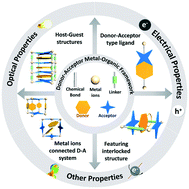Donor–acceptor systems in metal–organic frameworks: design, construction, and properties
Abstract
Metal–organic frameworks (MOFs), as an emerging material, have achieved incredibly fine control over the arrangement and mode of interaction of the donor (D) and acceptor (A) due to the diversification of their construction and the orderly structure of the frameworks. The construction and exploration of new D–A systems in MOFs has also become a wonderful strategy for the development of MOFs in optics, electronics, magnetics, catalysis, anti-counterfeiting, and other fields. This highlight aimed to give a brief introduction to the development of D–A MOFs, and the advantages of this class of materials are summarized in the aspects of design, construction, and properties.

- This article is part of the themed collection: 2022 Highlight article collection


 Please wait while we load your content...
Please wait while we load your content...